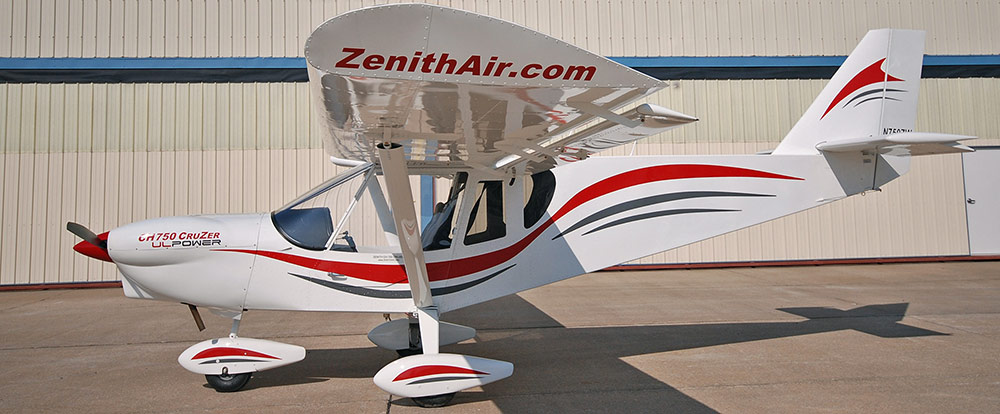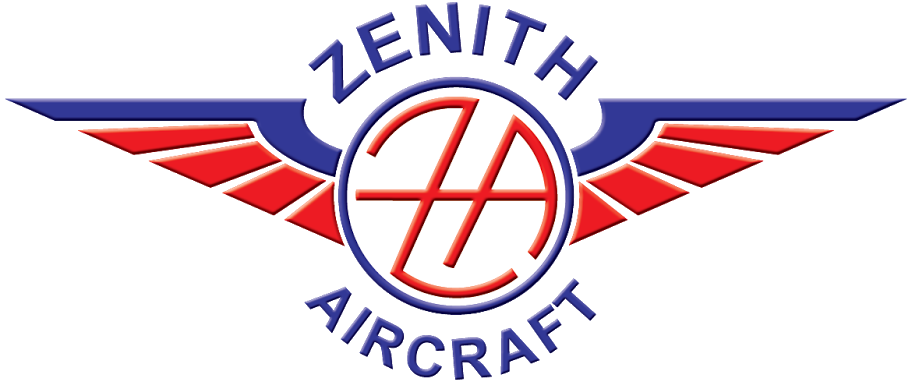Reviews - Zenith CH 750 Cruzer
Heintz and company are well known for favoring airfoil sections that offer high lift and excellent slow flight and gentle stall characteristics. The STOL CH 750 was built around a modified NACA 650-18 airfoil (with a fixed leading edge slat) with a fatter-than- normal thickness—17 percent. This gives lift but works against high speeds which is okay with the Heintz crew, because even in their low-wing designs, the emphasis is on safety, not high-speed capabilities. They know that a lot of homebuilders are low-time pilots, and they design aircraft that cater expressly to the needs of that pilot niche, which is one of the reasons tricycle landing gear are standard. They also are known for designing aircraft that are easy to build, and that’s where the new CruZer fits nicely into the Zenith 700 series.
“An important part of the STOL 750’s short-field capabilities are the wing’s fixed leading-edge slats,” Sebastien said. “We made them fixed, which is much less complex than movable, but that produces higher drag. On the CruZer, we eliminated the slats entirely because we recognized that only about 30 percent of the CH 750s built were ever landed off airport. Yes, many are flying out of tiny backyard runways, but we know that there are far more based on normal airports. And those owners aren’t interested in landing anywhere except on established runways. So, they don’t need to be able to get off the ground in 100 feet, but they do want to go faster than the 100-mph cruise speed that the 750 was giving them; so airframe drag was an issue.”

The CruZer shares the same firewall as the STOL CH 750 and the low-wing CH 650, making a wide series of engines available to power the new design. But the CruZer has a new tail that departs from the usual Zenith single-piece vertical surface by featuring a traditional rudder/vertical stabilizer unit. Also, the horizontal stabilizer/elevator surface is symmetrical in cross section in contrast to the asymmetrical, down-lifting surface on the STOL birds.
Although Sebastien said that the fuselage is basically a 750 fuselage, the many modifications such as the tail and the wider, more conventional instrument panel come close to making the CruZer a new design. It still maintains the 42-inch cabin width, which makes it nearly 3 inches wider than a Cessna 172. It’s actually the same width as that of a late model Cessna 182, but optional bulged doors add even more shoulder width.
“Besides the removing of the slats,” Sebastien said, “the most obvious visual change is that we replaced the fat wheels and tires with 5.00-by-5 and wheelpants; that alone produced around a 7-mph increase in cruise speed. However, if a builder wants, he can go with larger wheels and tires.”
Because Zenith envisioned the CruZer as a cruiser, weight wasn’t as much of an issue, so they gave up a few pounds in the engine compartment in favor of some bigger, more traditional engines. At the same time, they designed the firewall forward with enough flexibility that a builder could use state-of-the-art engines as they appear on the market. As displayed at Sun ’n Fun 2013, the CruZer was powered by UL- Power’s new 130-hp UL350iS 3.5-liter engine (214 cubic inches). This engine is one of a new breed of slightly larger displacement, flat-four, air-cooled light aircraft engines that are traditional in layout, including eliminating a reduction drive unit and going direct drive.

At the same time, they are state of the art in design, manufacturing, and operation; it’s FADEC equipped, among other things. Besides the ULPower engine, a builder has plenty of engine options available.
Sebastien said, “We set the cowling and engine compartment up so that the older, very available, and often less expensive Continental O-200 and Lycoming O-235 engines will both fit, and we make motor mounts for those and other engines. The UL engine only weighs 172 pounds whereas the O-235 weighs nearly 300 pounds installed, which is why there is so much room behind the UL 350iS. We have a long mount for that engine and short ones for the others.”
As with all Zenith designs, the aircraft is available in every form from plans to a quick-build kit. Constructed of flat-sheet aluminum, with very few complex parts, the aircraft is ready made for the scratchbuilder. However, if a builder decides to move up to any of the kits, the building time plummets, courtesy of Zenith’s huge CNC flatbed routers. The computer-controlled routers roam around over a flat sheet, putting the holes in the parts so they all matched. Sebastien said the 400-hour build time they quote to build from a quick-build kit is a realistic estimate, but variations will be introduced both by builder experience and the degree of finish. The more complex the paint and interior, the more time will be required. And unfortunately, the more the aircraft will weigh.
So how much less STOL and how much more of a cruiser is the CruZer? Sebastien said, “Where the STOL is off the ground in 100 feet and requires a 500-foot runway to safely take off and land with good margins, the CruZer gets off in 275 feet and needs 220 feet to land.”
That’s still very strong STOL performance, but Sebastien said, “In the CruZer, the average low-time pilot would be very safe flying off of 750 to 1,000 foot runways, assuming reasonable approaches. This would provide him with lots of safety margin. At the same time, however, he would have nearly 20 percent more cruise performance at the same fuel burn. It’s a much more efficient airplane for those who really don’t care about having the absolute ultimate in off-airport performance.”
It’s one of the unfortunate facts of life that nothing is free, and nowhere is this truer than in airplane performance. However, Zenith’s new CruZer looks as if it’ll scratch a couple of itches at the same time: It has a reasonable cruise speed with a low fuel burn yet it still has very respectable short-field performance. All of this is from easy-to-build straight lines and square corners.
Follow Us on Facebook

